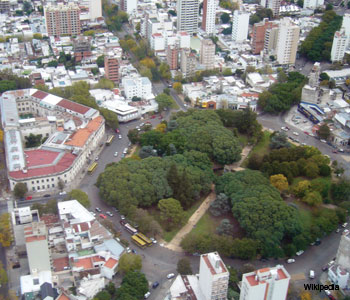Global Optics
Spectroscopy, Optics and Lasers in the City of the Diagonals
The city of La Plata has the highest concentration of scientific and techno-logical institutions in Argentina. Among these is the Optical Research Center, which is celebrating its 35th anniversary this year.
 Arial view of Plaza Dardo Rocha.
Arial view of Plaza Dardo Rocha.
The 35-year history of Argentina’s Optical Research Center is part of a story that began 130 years ago—in November 1882. That is when Governor Dardo Rocha founded the city of La Plata. Located 56 km to the southeast of Buenos Aires, it was designed by architect Pedro Benoit to serve as the capital of the Buenos Aires province. One of its peculiarities is its chessboard design with broad transverse avenues, earning it the nickname “City of the Diagonals.”
In 1887, a university was established in the region to represent the province as well. However, by 1905, the Argentine government made the decision to nationalize it, and the National University of La Plata (UNLP) was born.
Before the 1960s, optics research was scarce in La Plata. Two notable 20th century La Plata scientists include the astrophysicist Enrique Gaviola and the astronomer Ricardo Platzeck, who in 1942 designed the first stellar spectrograph in the world built entirely with mirrors. They also originated the caustics method for surveying optical surfaces, which was used in the creation of the Mount Palomar telescope, among others. Septimio Tesone, a lesser known La Plata physicist, contributed to optics by improving the Rayleigh criterion.
Regrettably these early pioneers did not spur the development of well-established optics groups at La Plata, although Adolfo Williams and Rafael Grinfeld did notable work in spectroscopy between the 1920s and the 1960s.
However, the invention of the laser changed everything. In the mid-1960s, a young Argentine physicist named Mario Garavaglia became the first laser scientist at La Plata. Having done doctoral work in Uppsala, Sweden, Garavaglia came home to receive his Ph.D. in laser spectroscopy at the National University of La Plata in 1965. He founded the Laboratory of Optics, Lasers and Spectroscopy (LEOL) within UNLP’s physics department in 1966. Around the same time, Mario Gallardo, another young scientist, returned from doing his postdoc in Lund, Sweden—where he had operated the first laser in that area. He joined Garavaglia at LEOL. From there, the lab quickly grew.
Garavaglia proposed expanding the laboratory to encompass more areas of optics, and in 1977 he and Gallardo founded the Centro de Investigaciones Opticas (CIOp), otherwise known as the Optical Research Center. He served as its director from 1977 to 1992. What began with a handful of researchers now has about 80 researchers, technologists, students and other staff. It is Argentina’s major center specializing in spectroscopy, optics and lasers.
In 1978, CIOp organized the first Latin-American seminar on the laser and its applications to physics and chemistry, which included presentations from Nicolaas Blomberger, Herwig Kogelnik, Aram Moradian, Wadt Willard and Helmut Schwarz, among others. The following year, it held the international seminar on Fourier optics, featuring such notables as Christopher Dainty, Joseph W. Goodman, Emmett Leith, Charles Vest and James Wyant.
CIOp’s commitment to its founding objectives make it a focal point for scientists in Argentina and throughout Latin America. For example, CIOp has earned regional distinction for its former course on lasers and optics in engineering, which was held annually from 1983-2003, and its current course on lasers and optics for sciences and engineering, which is held biennially and attended by about 1,000 participants throughout Latin America. It has spurred the formation of several research groups in Argentina, Chile, Brazil, Colombia and Venezuela.
In its early days, CIOp’s main areas of research were atomic spectroscopy, laser spectroscopy and Fourier optics, with metrological applications. Today, CIOp scientists focus on more than 20 lines of research, including opto-digital processing, integrated optics, nonlinear optics and much more. Researchers at the center also work with partners in the industrial and government sectors, providing technological assistance on several projects. For, example, CIOp participated in the development of several devices for the SAC-D/Aquarius satellite, a joint mission between the Argentinean Commission for Aerospace Activities and NASA.
Thirty five years after CIOp’s founding, its history has just begun. It is now starting to focus on technology transfer. In 2007, CIOp students established the CIOp-UNLP SPIE-OSA student chapter, which has become increasingly active over the past five years. The next generation of CIOp scientists is excited to be part of it promising future.
The author thanks Myrian Tebaldi for helping him develop this article, as well as Mario Garavaglia and Mario Gallardo for providing information on the history of CIOp and La Plata.
Log in or become a member to view the full text of this article.
This article may be available for purchase via the search at Optica Publishing Group.
Optica Members get the full text of Optics & Photonics News, plus a variety of other member benefits.
